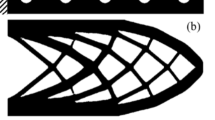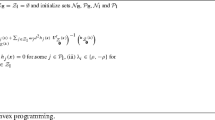Abstract
Optimization problems often depend on parameters that define constraints or objective functions. It is often necessary to know the effect of a change in a parameter on the optimum solution. An algorithm is presented here for tracking paths of optimal solutions of inequality constrained nonlinear programming problems as a function of a parameter. The proposed algorithm employs homotopy zero-curve tracing techniques to track segments where the set of active constraints is unchanged. The transition between segments is handled by considering all possible sets of active constraints and eliminating nonoptimal ones based on the signs of the Lagrange multipliers and the derivatives of the optimal solutions with respect to the parameter. A spring-mass problem is used to illustrate all possible kinds of transition events, and the algorithm is applied to a well-known ten-bar truss structural optimization problem.
Similar content being viewed by others
References
Haftka, R.T.; Gürdal, Z.; Kamat, M.P. 1990:Elements of structural optimization. 2nd edition. Dordrecht: Kluwer Academic Publishers
Lundberg, B.N.; Poore, A.B. 1990: Bifurcations and sensitivity in parametric nonlinear programming.Proc. Third Air Force/NASA Symp. on Recent Advances in Multidisciplinary Analysis and Optimization (held in San Francisco, CA., Sept. 24–26), pp. 50–55
Rao, J.R.J.; Papalambros, P.Y. 1989: A nonlinear programming continuation strategy for one parameter design optimization problems.Proc. ASME Design Automation Conf., pp. 77–89
Rao, J.R.J.; Papalambros, P.Y. 1989: External behaviour of one parameter families of optimal design models.Proc. ASME Design Automation Conf., pp. 91–100
Shin, Y.S.; Haftka, R.T.; Watson, L.T.; Plaut, R.H. 1988: Tracing structural optima as a function of available resources by a homotopy method.Comp. Meth. Appl. Mech. Eng. 70, 151–164
Sobieszczanski-Sobieski, J.; Barthelemy, J.-F.M.; Riley, K.M. 1982: Sensitivity of optimum solutions to problem parameters.AIAA J. 20, 1291–1299
Watson, L.T.; Billups, S.C.; Morgan, A.P. 1985: HOMPACK: a suite of codes for globally convergent homotopy algorithms.Tech. Rep. 85-34, Dept. of Industrial and Operations Eng., Univ. of Michigan, Ann Arbor, MI,ACM Trans. Math. Software 13, (1987) 281–310
Watson, L.T. 1985: Numerical linear algebra aspects of globally convergent homotopy methods.Tech. Rep. TR-85-14, Dept. of Computer Sci., VPI & SU, Blacksburg, VA, SIAM Rev. 28, (1986) 529–545
Watson, L.T. 1979: A globally convergent algorithm for computing fixed points of C2 maps.Appl. Math. Comp. 5, 297–311
Author information
Authors and Affiliations
Additional information
Communicated by J. Sobieski
Rights and permissions
About this article
Cite this article
Rakowska, J., Haftka, R.T. & Watson, L.T. An active set algorithm for tracing parametrized optima. Structural Optimization 3, 29–44 (1991). https://doi.org/10.1007/BF01743487
Received:
Issue Date:
DOI: https://doi.org/10.1007/BF01743487




